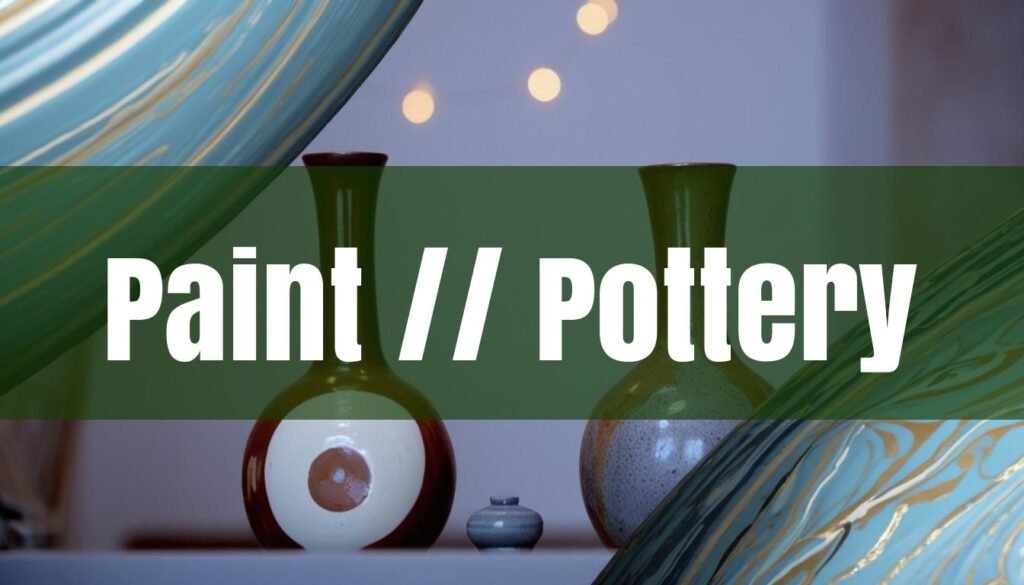Painting on pottery can transform a simple clay form into a personalized piece of art. Whether you’re a seasoned artist or a beginner, understanding the process and techniques involved can help you achieve stunning results. This guide covers everything from selecting the right pottery and paints to firing and sealing your finished creation, ensuring your artwork stands the test of time.
Choosing Your Pottery and Paints
The first step in painting pottery is selecting the right base. Bisque-fired pottery is a popular choice because it has already been fired once and is porous, allowing paints to adhere well. However, you can also paint on glazed ceramic items, such as mugs, though this requires specific paints and preparation. When choosing your paints, consider the type of pottery you’re using and the intended use of the final piece. Acrylic paints are versatile and work best on unglazed pottery due to their bright colors, non-toxic properties (in most brands), and quick-drying nature. They’re also elastic, helping them stay intact over time. For glazed ceramics, porcelain paints are an excellent option as they adhere better to the smooth surface. These paints can be cured in a conventional oven, making them waterproof and washable. Brands like Decola are highly regarded for their pigment-dense ceramic and glass paints, offering vibrant, long-lasting, and even dishwasher-safe results after baking. Other options include latex paints, which are water-based and require multiple layers for a solid finish, and enamel paints, which are oil-based, durable, and heat-resistant, providing a glossy texture ideal for glazed pottery. For purely decorative pieces, traditional paints can be used, but be aware that these may flake or peel if exposed to moisture or outdoor conditions. Ultimately, selecting paints that adhere well to the clay type, are durable after firing, and are food-safe if needed is crucial.
This video from Red Rocking Bird gives a great overview of using air-dry clay, and whether or not to glaze it. It’s a helpful resource for anyone working with this type of clay.Preparing the Pottery Surface
Proper surface preparation is essential for ensuring paint adheres correctly and your design lasts. Start by cleaning the ceramic piece with soap and water to remove any oils, dirt, or contaminants. Let it dry completely before proceeding. For glazed ceramics, lightly sand the surface with fine-grit sandpaper to create a rougher texture that the paint can grip. This step is crucial as it removes some of the old glaze, allowing for better adhesion of the new paint layer. If you’re working with air-hardening clay, ensure it is completely dry and sealed before painting, using a clay varnish or acrylic gloss medium to waterproof it. Porous clay surfaces will otherwise absorb moisture from the paints, causing them to soften and potentially ruining your design. After sanding, you may want to apply a primer to further enhance paint adhesion, especially on particularly smooth surfaces. Wiping the pottery with a damp sponge before painting can also remove any dust that might affect the final finish. For more information, see this guide to unlocking ceramic surface design.
Painting Techniques and Artistic Effects
Once your pottery is prepped, it’s time to unleash your creativity with various painting techniques. Brushwork is fundamental, and selecting the right brush is essential. Flat-tipped brushes are perfect for shading and geometric work, while small, flat-tipped brushes are ideal for intricate stencil designs. Experiment with layering translucent paints using sponges to create textured patterns with depth, achieving rustic, weathered effects. Sponging can cover large areas quickly, with varying opacity depending on pressure and paint saturation. Stenciling can be achieved using lace, taped down to create intricate details by painting over it and carefully removing it once the desired color saturation is achieved. Splattering paint with a firm brush or toothbrush by running your finger over the bristles adds bold, layered effects. For those seeking more specialized effects, marbling can be achieved using shaving cream as a base, adding drops of ceramic paints, swirling, and dipping the pottery item. Ombré effects are created by blending colors together seamlessly. Consider using acrylic or oil-based pens for easy decoration, or painter’s tape for creating straight lines and shaded sections. Other fun techniques include creating scales, fur textures, fingerprints turned into animals or bugs, and painting inspirational phrases or abstract designs.
Sealing and Firing
Sealing and firing your painted pottery are crucial steps for ensuring durability and longevity. The method you choose depends on the type of paint used and the intended function of the pottery. For pieces painted with acrylics or other non-ceramic paints, air-drying sealants can provide a protective layer, though these pieces are best suited for decorative purposes as they may not withstand washing or outdoor exposure. For more durable, functional pieces, kiln-firing is necessary. Before firing, the painted item is typically dipped in a clear glaze. The kiln heats up to temperatures around 1830 to 1940 degrees Fahrenheit, and the firing process can take up to 30 hours, including cooling time. For those without access to a kiln, some porcelain paints can be cured in a conventional oven at low temperatures (around 120 degrees Celsius), though this method is limited to certain types of clay and paint, and glazing is not possible. Raku firing, an alternative method, involves a bisque fire followed by firing in a pit at temperatures between 760 to 1100 degrees Celsius, then rapidly cooling the pottery in water or sawdust. Check out this article on kiln care for more information.
Avoiding Common Mistakes
Several common mistakes can occur when painting pottery, but with awareness, they can be prevented. Uneven application can be avoided by applying thinner layers rather than piling on the paint. Ensure the pottery is free of dust, grease, and oils, as these can repel the glaze and ruin the finish. If you make a mistake, a damp sponge can remove unwanted paint layers, but remember to repaint those areas. Avoid using non-ceramic paints, such as acrylics, if you intend to fire the pottery, as they may burn away or cause glaze issues. When working with clay, improper wedging can lead to air pockets, making it difficult to center and form the clay on a wheel. Maintaining consistent moisture in the clay is also essential; too little water results in a dry, unworkable clay, while too much water can cause the clay to collapse. Applying even pressure when shaping the clay prevents uneven walls and thin spots. Finally, drying the pottery slowly, covered with plastic, helps prevent cracks. By avoiding these common pitfalls, you can ensure a smoother, more successful pottery painting experience.





